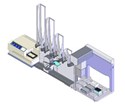Automating The Analysis Of Cell Viability

Menlo Park,CA - Velocity11,an Agilent Technologies company, has released a new technical note that describes a combination of their Bravo liquid handler, BenchCel plate handling system and the CellTiter-Glo kit from Promega for automating the analysis of cell viability.
The automated cell viability workstation described within the technical note is shown to provide a reliable, efficient solution for analysing cell viability. Using the described protocol up to 65 plates can be run without user intervention. The typical throughput for the described set-up was found to be about 3 hours for 50 plates, depending on exact protocol and liquid handling steps.
Cell viability testing is an important part of the ADME-Tox compound profiling approach. The demand for these type of assays is high due to the increasing output from High Throughput Screening (HTS) and the pressure to "frontload" as much toxicity testing as possible during the Drug Discovery process. There are a number of different approaches for cell viability testing. In this new application brief the authors outline the protocol using the Promega CellTiter-Glo kit as it is ideally suited for adaptation on automated workstations.
The combination of Velocity11's Bravo liquid handler and the BenchCel plate handling system is shown to allow users to run the assay with high throughput and maximum walk-away time. Plates are delivered to the Bravo, reagent is added and plates are placed on shaking devices. The reagent is added without tip touching, therefore only one tip-box is needed for the total run. The plates are transported back to the BenchCel for room temperature incubation, directly followed by signal detection on a microplate reader. The automated workstation ensures that all process and incubation times are accurately managed, to ensure reliable and repeatable results.
SOURCE: Velocity11
